Frequently Asked Questions
- What are my treatment options?
- What is sclerotherapy?
- What is ultrasound-guided sclerotherapy?
- Is sclerotherapy safe?
- What is a duplex ultrasound examination?
- What are laser and radiofrequency sealing of veins?
- What new treatment options exist for patients who have abnormal blood flow in the major vein trunks other than vein stripping?
- Why can't I just have the branches injected or removed if the main superficial trunk is abnormal?
- How will the blood in my veins get back to my heart after all of the abnormal veins are removed or destroyed?
- Do I have to treat both legs?
- Why do doctors recommend gradient compression stockings?
Phlebology is the branch of medicine that deals with veins and disease of veins.
A Phlebologist is a physician who specializes in the diagnosis and treatment of vein disorders.
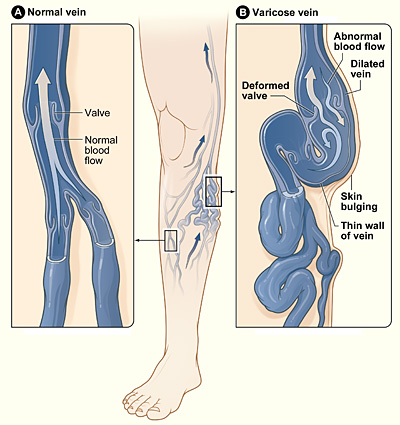
Varicose Veins are veins that become abnormally swollen and large, usually due to defective valves in the vein. Varicose veins are sometimes bluish in color, protrude from the surface of the skin, and frequently have a winding or worm-like appearance.
Varicose veins are a very common condition in the United States and affect approximately 15 percent of men and approximately 25 percent of women.
Varicose veins are the blue or purplish enlarged veins you typically see bulging out of one's leg. The word "varicose" is derived from the Latin root word "varix," which is translated in English as "twisted." Any vein in your body may become varicose, however, its important to note that this condition or varicose veins exists most often in the legs and feet. Varicose veins occur in the legs and lower extremities because standing and walking increases the pressure in the veins in the lower half of your body.
Is it only a cosmetic concern? For many men and women, varicose veins and spider veins (these are the smaller and more common variation of varicose veins) makes them feel less attractive. However, it's important to note that for others, varicose veins cause aching pain and discomfort. This condition may lead to serious problems if not treated. Moreover, varicose veins may also serve as an indication that the individual is at a higher risk of other disorders of the circulatory system.
As with many other health related issues, self-help measures work well for prevention; compression stockings and changing certain aspects in one's lifestyle.
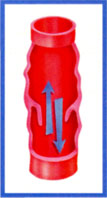
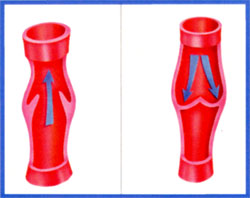
Increase in the diameter of a vein results in the malfunction of valves inside of the vein that are designed to prevent blood from flowing backward in the vein. An inherited weakness of the vein wall (genetic) and circulating hormones that relax the smooth muscle of the vein wall are the most common causes. Females have high levels of such a hormone, the hormone progesterone. Pregnancies, obesity, hormone replacement therapy, the use of female oral contraceptives as well as occupations that require a standing position are additional causes of varicose veins. Since females usually have multiple risk factors for the development of varicose veins, about three fourths of the persons who have varicose veins are women and 25% are men.
Pregnant women sometimes complain of developing varicose veins. This is true. Pregnancy increases the volume of blood in a woman's body, however, it decreases the flow of blood from the legs to the pelvis. This change in circulation is designed to support the growing baby, but it can produce an unfortunate side effects such as enlarged veins in the legs. Varicose veins may appear for the first time during pregnancy. It has been observed that the varicose veins may worsen during late pregnancy because the uterus exerts greater pressure on the veins in your legs.
Some are very surprised to learn that hemorrhoids are actually varicose veins located in and around the anus. Moreover, this condition is very common in the United States. By age 50, about half of adults have had to deal with the itching, bleeding and pain that often signal the presence of hemorrhoids.
Hemorrhoids, also known as "piles", are swollen veins in your anus and rectum. The causes include straining during a bowel movement or the increased pressure during pregnancy.
Effective medications and procedures are readily available to treat hemorrhoids. Fortunately, in many cases hemorrhoids may require only lifestyle changes.
A number of people do not experience any discomfort with varicose veins, however, certain people do. For those that do experience discomfort, below are some of the symptoms
- Achiness or heavy feeling in one's legs; burning, throbbing, muscle cramping and swelling in the lower legs.
- Itching around one or more of your veins in the legs.
- Skin ulcers near your ankle, which represent a severe form of vascular disease and require immediate attention.
If you have varicose veins, typically prolonged sitting or standing tends to make your legs feel worse. The varicose veins are easy to spot because they are dark purple or blue in color and sometimes appear twisted and bulging. The most common spot they appear is on the inside of the leg or on the backs of calves. But don't let that fool you, they can form anywhere on your legs, from your groin to your ankle.
Some are very surprised to learn that hemorrhoids are actually varicose veins located in and around the anus. Moreover, this condition is very common in the United States. By age 50, about half of adults have had to deal with the itching, bleeding and pain that often signal the presence of hemorrhoids.
Hemorrhoids, also known as "piles", are swollen veins in your anus and rectum. The causes include straining during a bowel movement or the increased pressure during pregnancy.
Effective medications and procedures are readily available to treat hemorrhoids. Fortunately, in many cases hemorrhoids may require only lifestyle changes.
Varicose veins are a problem that can be successfully treated but the disorder cannot be permanently cured. The treatment of the abnormal veins does not remove the original tendency of a patient to develop varicose veins. Therefore, many patients need to return for maintenance treatments after their initial treatment is completed.
There's no way to completely prevent varicose veins. But improving your circulation and muscle tone can reduce your risk of developing varicose veins or getting additional ones. Traditional, common-sense approaches include:
- Exercise. Get your legs moving. Walking is a great way to encourage blood circulation in your legs. Your doctor can recommend an appropriate activity level for you.
- Watch your weight, and your diet. Shedding excess pounds takes unnecessary pressure off your veins. What you eat makes a difference, too. Follow a low-salt, high-fiber diet to prevent the swelling that may result from water retention and constipation.
- Watch what you wear. Avoid high heels. Low-heeled shoes work calf muscles more, which is better for your veins. Don't wear tight clothes around your waist, legs or groin. Tight panty-leg girdles, for instance, can restrict circulation.
- Elevate your legs. To improve venous circulation, take several short breaks daily to elevate your legs above the level of your heart. For example, lie down with your legs resting on three or four pillows.
- Avoid long periods of sitting or standing. Make a point of changing your position frequently to encourage blood flow. Try to move around at least every 30 minutes.
- Don't sit with your legs crossed. This position can aggravate circulation problems.
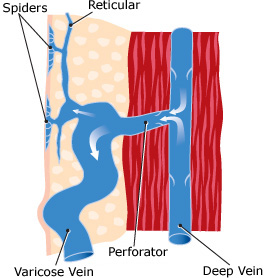
Spider veins, or telangiectasias, are tiny veins that constantly look dilated. Caused by weak vascular walls and inefficient circulation, spider veins cause no health problems but many people feel they look unappealing. Spider veins can sometimes resemble a spider: a large dark spot with thin veins radiating out of it, or they may appear in other patterns and variations in different places in the body. Frequently occurring in the legs, spider veins can be dark or lighter shades of blue, purple, or red.
A skin ulcer is caused by a venous reflux disorder that is called a venous stasis ulcer. Early signs that a venous stasis ulcer may develop include a darkening of the skin in the area of the ankle. Gradually, the skin may become leathery or waxy in appearance. Without treatment of the venous disease, the skin may breakdown and bleeding may occur.
Vein treatment programs are designed to treat visible varicose veins and to treat abnormal veins that may not be visible but that may be the source of the visible varicosities. If varicose veins are the only abnormality detected by the treating physician, the treatment involves surgical removal of the visible varicose veins (micro-incision phlebectomy) or the injection of chemicals (sclerosants) into the vein (sclerotherapy).
Sclerotherapy is the treatment of varicose veins by injection of the veins with chemicals that cause destruction of the veins. Many patients who select this treatment option for cosmetic reasons notice improvement in the way that their legs feel after treatment.
Visual sclerotherapy refers to injection of surface veins that are visible to the naked eye. Some veins that need to be treated are below the surface of the skin and cannot be injected safely without the aid of ultrasound imaging assistance.
Most patients do not experience any complications from sclerotherapy. However, some patients develop changes in skin pigment in locations where the veins are injected. Some patients may experience chemical burns of the skin while a rare patient may develop an allergy to the medication. Serious complications such as deep vein blood clots and unintentional arterial injection occur rarely.
The venous duplex examination permits your phlebologist to see the anatomy and check the flow characteristics of the veins beneath your skin. Useful information is gathered that your physician can use to adequately diagnose your specific vein problem and to plan and guide treatment.
Light energy (laser) or electrical energy (radiofrequency) may be used to seal shut abnormal main superficial trunk veins. Both treatments involve the application of heat energy to inside of the long or short saphenous veins. Usually treatment of the GSV starts at a location in the vein at or below the knee. The GSV is then treated from its junction to the deep system at the level of the groin down to the entry site near the knee. Ultrasound guided injections may also be used to seal the GSV or LSV.
In order to control the backward flow of blood in these large veins, the vein that is the source of the visible varicosities must be sealed shut or removed. The vein may be sealed shut using energy sources such as a laser, or radiofrequency energy electrical energy, or by ultrasound guided sclerotherapy injections.
For the treatment of the visible veins to last a long time, the source that may not be visible to the naked eye must be controlled as well. From a practical standpoint some insurance carriers will not pay for treatment of branch varicosities if an abnormal main trunk is not treated at the same time or before the branches are treated.
The backward flow of blood in varicose veins and main superficial trunks, the great saphenous vein (GSV) and lesser saphenous (LSV) vein actually interfere with the normal venous return of blood. Removal of these areas of abnormal circulation actually improves circulation of blood in the treated limb. It is this improvement in limb circulation that causes improvement of symptoms of tiredness and heaviness in the limb.
The abnormal limb or limbs should be treated thoroughly for best results. They may be treated at the same time or after one another.
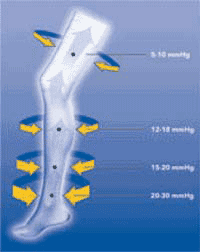
pressure to improve blood flow
The properly fitted gradient compression stocking can temporarily reverse the effects of vein disease and lessen the discomfort as well as skin damage. Many insurance companies require a trial of stocking use before approving definitive therapy.
TO FIND A VARICOSE VEINS OR SPIDER VEINS CENTER AND DOCTOR NEAR YOU, VISIT VEINSonline.COM.